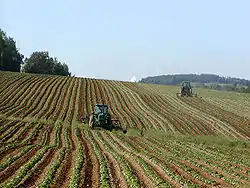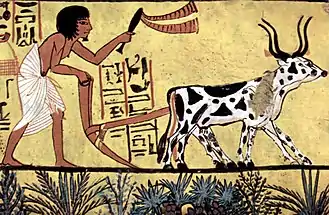Monoculture
Monoculture is the agricultural practice of growing a single crop, plant, or livestock species, variety, or breed in a field or farming system at a time. Polyculture, where more than one crop species is grown in the same space at the same time, is the alternative to monoculture.[1] Monoculture is widely used both in industrial farming and in organic farming. It has allowed farmers to increase efficiency in planting, managing, and harvesting but it can also increase the risk of diseases or pest outbreaks.

| Agriculture |
|---|
 |
|
|
Continuous monoculture, or monocropping, where farmers raise the same species year after year,[2] can lead to the quicker buildup of pests and diseases, and then their rapid spread where a uniform crop is susceptible to a pathogen. Monocultures of perennials, such as African palm oil,[3] sugar cane,[4] and pines,[5] can lead to environmental problems. Diversity can be added both in time, as with a crop rotation or sequence, or in space, with a polyculture.
The term "oligoculture" has been used to describe a crop rotation of just a few crops, as practiced in several regions of the world.[6]
The concept of monoculture can also extend to (for example) discussions of variety in urban landscapes.[7]
Agriculture
The term is used in agriculture and describes the practice of planting one species in a field. Examples of monoculture include lawns and most fields of wheat or corn and many orchards producing tree fruit.
| Diversity in time | |||||
|---|---|---|---|---|---|
| Low | Higher | ||||
| Cyclic | Dynamic (non-cyclic) | ||||
| Diversity in space | Low | Monoculture, one species in a field | Continuous
monoculture, monocropping |
Crop rotation
(rotation of monocultures) |
Sequence of monocultures |
| Higher | Polyculture, two or more species
intermingled in a field |
Continuous
polyculture |
Rotation of polycultures | Sequence of polycultures | |
The term is also used where a single breed of farm animal is raised in large-scale concentrated animal feeding operations (CAFOs).
Benefits
In crop monocultures, each plant in a field has the same standardized planting, maintenance and harvesting requirements resulting in greater yields and lower costs. When a crop is matched to its well-managed environment, a monoculture can produce higher yields than a polyculture.[9] In the last 40 years, modern practices such as monoculture planting and the use of synthesized fertilizers have reduced the amount of additional land needed to produce food,[10] called land sparing.
Risks
Diverse rotations of crop monocultures can minimize the risk of disease and pest outbreaks.[11] However, the shorter the rotation (fewer crops included) the higher the risk. There are examples of short, two-year rotations selecting for pests that are adapted to such rotations [12] Therefore, rotations of 3 or more crops are recommended for pest and disease management.
Forestry
In forestry, monoculture refers to the planting of one species of tree.[13] Monoculture plantings provide greater yields and more efficient harvesting than natural stands of trees. Single-species stands of trees are often the natural way trees grow, but the stands show a diversity in tree sizes, with dead trees mixed with mature and young trees. In forestry, monoculture stands that are planted and harvested as a unit provide limited resources for wildlife that depend on dead trees and openings since all the trees are the same size; they are most often harvested by clearcutting, which drastically alters the habitat. The mechanical harvesting of trees can compact soils, which can adversely affect understory growth.[14] single-species planting also causes trees to be more vulnerable when they are infected with a pathogen, or attacked by insects,[15] or affected by adverse environmental conditions.[16]
Genetic monocultures
While often referring to the production of the same crop species in a field (space), monoculture can also refer to the planting of a single cultivar across a larger regional area, such that there are numerous plants in the area with an identical genetic makeup to each other. When all plants in a region are genetically similar, a disease, to which they have no resistance, can destroy entire populations of crops. As of 2009 the wheat leaf-rust fungus occasioned a great deal of worry internationally, having already decimated wheat crops in Uganda and Kenya, and having started to make inroads into Asia as well.[17] Given the very genetically similar strains of much of the world's wheat crops following the Green Revolution, the impacts of such diseases threaten agricultural production worldwide.
Great Famine of Ireland
In Ireland, exclusive use of one variety of potato, the "lumper", led to the Great Famine of 1845–1849. Lumpers provided inexpensive food to feed the Irish masses. Potatoes were propagated vegetatively with little to no genetic variation. When Phytophthora infestans arrived in Ireland from the Americas in 1845, the lumper had no resistance to the disease, leading to the nearly complete failure of the potato crop across Ireland.
Bananas
Until the 1950s, the Gros Michel cultivar of banana represented almost all bananas consumed in the United States because of their taste, small seeds, and efficiency to produce. Their small seeds, while more appealing than the large ones in other Asian cultivars, were not suitable for planting.[18] This meant that all new banana plants had to be grown from the cut suckers of another plant. As a result of this asexual form of planting, all bananas are grown had identical genetic makeups which gave them no traits for resistance to Fusarium wilt, a fungal disease that spread quickly throughout the Caribbean where they were being grown. By the beginning of the 1960s, growers had to switch to growing the Cavendish banana, a cultivar is grown in a similar way. This cultivar is under similar disease stress since all the bananas are clones of each other and could easily succumb as the Gros Michel did.[19]
Cattle
Many of today's livestock production systems rely on just a handful of highly specialized breeds. Focusing heavily on a single trait (output) may come at the expense of other desirable traits - such as fertility, resistance to disease, vigor, and mothering instincts. In the early 1990s, a few Holstein calves were observed to grow poorly and died in the first 6 months of life. They were all found to be homozygous for a mutation in the gene that caused bovine leukocyte adhesion deficiency. This mutation was found at a high frequency in Holstein populations worldwide. (15% among bulls in the US, 10% in Germany, and 16% in Japan.) Researchers studying the pedigrees of affected and carrier animals tracked the source of the mutation to a single bull that was widely used in the industry. Note that in 1990 there were approximately 4 million Holstein cattle in the US, making the affected population around 600,000 animals.[20]
Benefits of genetic diversity
While having little to no variety in the genetics of an agricultural system can have drawbacks, increasing genetic diversity by introducing organisms with varying genes can divert them and make the system more sustainable. For example, by having crops with varying genetic traits for disease and pest resistance, there is a much lower chance of having those pests or diseases spread throughout the area. This is because if one crop becomes infected with a particular strain of disease or species of pest, there is a chance that the other plants around it will have genes that protect them from that strain/species.[21] This can help increase crop productivity while simultaneously lowering pesticide usage and risk of exposure.
Polyculture
The environmental movement seeks to change the popular culture by redefining the "perfect lawn" to be something other than a turf monoculture, and seeks agricultural policy that provides greater encouragement for more diverse cropping systems. Local food systems may also encourage growing multiple species and a wide variety of crops at the same time and same place. Heirloom gardening and raising heritage livestock breeds have come about largely as a reaction against monocultures in agriculture.[22]
See also
References
- Connor, David J.; Loomis, Robert S.; Cassman, Kenneth G. (28 April 2011). Crop Ecology. ISBN 9781139500326.
- "Crop Science - ICSC2004".
- Leech, Garry (2009). "The Oil Palm Industry: A Blight on Afro-Colombia". NACLA Report on the Americas. 42 (4): 30–34. doi:10.1080/10714839.2009.11725459. S2CID 157642907.
- Correa-García, Esteban (Summer 2018). "Territorial transformations produced by the sugarcane agroindustry in the ethnic communities of López Adentro and El Tiple, Colombia". Land Use Policy. 76: 847–860. doi:10.1016/j.landusepol.2018.03.026.
- Cordero, Adolfo. "Large scale eucalypt plantations associated to increased fire risk". PeerJ Preprints. doi:10.7287/peerj.preprints.3348v1.
-
Compare:
Denison, R. Ford (2012). Darwinian Agriculture: How Understanding Evolution Can Improve Agriculture. Princeton: Princeton University Press (published 2016). p. 3. ISBN 9780691173764.
Regionally and globally, we practice oligoculture, relying mainly on only a few crops, particularly corn (maize), wheat, and rice.
-
For example:
Gomez, Rafael; Isakov, Andre; Semansky, Matthew (2015). Small Business and the City: The Transformative Potential of Small Scale Entrepreneurship. Rotman-UTP Publishing. Toronto: University of Toronto Press. pp. 15–16. ISBN 9781442696518.
[...] the idiosyncratic nature of what an urban main street can offer local residents stands in sharp contrast to the predictable monoculture of contemporary retail development.
- "Ecological Theories, Meta-Analysis, and the Benefits of Monocultures". Retrieved 18 September 2015.
- Cardinale, Bradley J.; Matulich, Kristin L.; Hooper, David U.; Byrnes, Jarrett E.; Duffy, Emmett; Gamfeldt, Lars; Balvanera, Patricia; O’Connor, Mary I.; Gonzalez, Andrew (1 March 2011). "The functional role of producer diversity in ecosystems". American Journal of Botany. 98 (3): 572–592. doi:10.3732/ajb.1000364. hdl:2027.42/141994. ISSN 0002-9122. PMID 21613148.
- G. Tyler Miller; Scott Spoolman (24 September 2008). Living in the Environment: Principles, Connections, and Solutions. Cengage Learning. pp. 279–. ISBN 978-0-495-55671-8. Retrieved 7 September 2010.
- Bullock, D. G. (January 1992). "Crop rotation". Critical Reviews in Plant Sciences. 11 (4): 309–326. doi:10.1080/07352689209382349. ISSN 0735-2689.
- Levine, Eli; Spencer, Joseph L.; Isard, Scott A.; Onstad, David W.; Gray, Michael E. (2002). "Adaptation of the Western Corn Rootworm to Crop Rotation: Evolution of a New Strain in Response to a Management Practice". American Entomologist. 48 (2): 94–107. doi:10.1093/ae/48.2.94. ISSN 2155-9902.
- Monoculture Forestry
- http://www.umich.edu/~nre301/forestry-02.doc
- Richardson, David M., ed. (2000). Ecology and biogeography of Pinus. Cambridge, U.K. p. 371. ISBN 978-0-521-78910-3.
- "Forestry".
- Vidal, John (19 March 2009). "'Stem rust' fungus threatens global wheat harvest". The Guardian. London. Retrieved 13 May 2010.
- "Gros Michel". The banana knowledge platform of the ProMusa network. Retrieved 8 June 2019.
- Schwarzacher, Trude; Heslop-Harrison, J. S. (1 October 2007). "Domestication, Genomics and the Future for Banana". Annals of Botany. 100 (5): 1073–1084. doi:10.1093/job/mcm191. ISSN 0305-7364. PMC 2759213. PMID 17766312.
- Williams, J.L. (22 October 2015). "The Value of Genome Mapping for the Genetic Conservation of Cattle". The Food and Agriculture Organization of the United Nations. Rome. Archived from the original on 6 March 2016. Retrieved 22 October 2015.
- Hajjar, Reem; Jarvis, Devra I.; Gemmill-Herren, Barbara (February 2008). "The utility of crop genetic diversity in maintaining ecosystem services". Agriculture, Ecosystems & Environment. 123 (4): 261–270. doi:10.1016/j.agee.2007.08.003. ISSN 0167-8809.
- Lie-Nielsen, Kirsten. "Why Raise Heritage Breeds of Livestock?". Mother Earth News. Ogden Publications. Retrieved 24 January 2020.
External links
| Look up monoculture in Wiktionary, the free dictionary. |